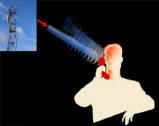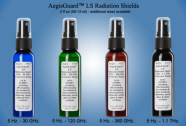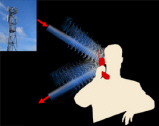
| Did You Know? | |
|
|
 |
 |
 |
| Without
AegisGuard™ LS |
AegisGuard™ LS For Wireless Products & Networks |
With AegisGuard™ LS |
| According to a report published in the February, 2003 issue of Microwave
News, the FDA knew as far back as 1993 wireless products "can accelerate the development
of cancer," Click here for additional information. Hands-free headsets are not as safe as you think they are. Your phone's radiation increases when you use a conductive shield, or one that absorbs radiation. A report prepared by the United Kingdom government's Independent Expert Group on Mobile Phones (IEGMP) was released on May 11, 2000. It stated "We conclude therefore that it is not possible at present to say that exposure to RF radiation, even at levels below national guidelines, is totally without potential adverse health effects, and that the gaps in knowledge are sufficient to justify a precautionary approach." The report presented numerous conclusions and recommendations, such asdiscouraging the marketing of mobile phones to children and their use of them, an investigation into the health risks associated with the use of hands free headsets, radiation exposure levels (expressed in SAR) should appear on wireless product packages and literature, the circulation of pamphlets by the government to every household advising the possible health risks and new tower approval guidelines. Click here for a summary of the report and its recommendations. Phone manufacturers began applying for patents in 1992 with designs for lowering the health risks. Specific Absorption Rate (SAR) methods used to confirm the safety of your phone are being debated. See AegisGuard FAQ's for additional information. |
| Bluetooth, 3Gm, 4G and 5G Specifications The Bluetooth, 3G, 4G and 5G wireless technology standards are for small form factor, low-cost, wireless communication and networking between PCs, mobile phones and other electronic products. They have been adapted for use worldwide. |
|
Since 1999, The Wireless Industry Has Persistently
Promoted Raising Radiation
Exposure Limits Television news shows broadcast in the United States and Western Europe during the last half of 1999, combined with additional worldwide news coverage, has resulted in increased public awareness about the health risks associated with radiation emitted by mobile phones. Government agencies in the United States, such as the FCC, FDA and US Congress, and agencies in other nations, responded with a series of long-term initiatives. During the summer of 1999, Dr. Om Gandhi reported that many mobile phones exceed current radiation exposure limits in the ear. The current limits are being debated worldwide because highly respected scientists believe they are already too high. Despite Dr. Om's report and numerous studies presenting irrefutable evidence about the health risks, wireless industry representatives attending an IEEE (Institute of Electrical and Electronics Engineers) meeting during October, 1999 in Atlanta, Georgia, proposed to the IEEE's SCC-28 (Standards Coordinating Committee 28), Subcommittee 4 (SC-4) that the current limits be raised. IEEE's SCC-28 encompasses emission standards from 3 KHz. to 300 GHz. Representatives from Motorola and Nokia proposed that "for the general public, the outer ear should be considered an extremity, similar to the hands, feet, wrists and ankles, and not a vital organ." The exposure limits for extremities are higher than the rest of the body, and they continued with "thus it is not necessary to protect the outer ear against RF exposure at the same level as the brain. If the limit for the ear is raised, maximum power of phones will not be limited unnecessarily." It was reported after the meeting that the members of SC-4 unanimously supported this proposal. |
| Patent Applications Phone manufacturers including Alcatel, Ericsson, Hitachi, Mitsubishi and NEC applied for patents as early as 1992 that included component designs to lower radiation health risks using various techniques. For example, one patent application describes a warning device that signals the user when the maximum permitted output power is being approached so they can stop using the phone. |
| U.S. Senate Bill S.800 The U.S. Senate and U.S. House of Representatives passed Bill S.800 on August 5, 1999 and October 14, 1999, respectively, to establish '911' as the national emergency telephone number. Entitled the `Wireless Communications and Public Safety Act of 1999', it grants phone carriers and vendors (phone manufacturers and dealers) the same immunity as wireline carriers for any liability associated with the use of their products and services. Click here and read the third paragraph of the Bill S.800 Summary. Then click 'Continue to Section 4" at the end of the paragraph for the Section in Bill S.800 where vendors are included as "providers of wireless service" and immunity was granted to them by the removal of "911" in the Section heading. |
| FDA U.S. phone safety standards are endorsed by the Federal Communications Commission (FCC), who admit they "are primarily a regulatory agency and not an expert on matters pertaining to health and safety." The Center for Devices and Radiological Health (CDRH) division of the Food and Drug Administration (FDA) is responsible for establishing safety standards and ensuring compliance for radiation emitting products sold in the U.S. that may endanger public health, yet they were merely an advisor instead of an authority in any capacity for cellular phones until October 20, 1999. On that date, a U.S. nationwide news broadcast exposed information about cellular phone radiation that resulted in immediate responses from the FCC, FDA and the cellular industry (CTIA. Despite accusations that the health effects of cellular phone radiation are being withheld from consumers by the cellular industry and the government, the FDA proposed a collaborative project with CTIA to investigate this issue. |